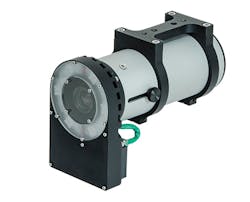Lighting and Illumination: Integrated controllers ease camera and lighting configuration
Developers of machine vision systems know that proper choice of lighting and camera components is key to any successful systems design. To accomplish this, developers face a number of choices when choosing lighting components - whether to integrate LED lighting with internal or external current controllers, and whether to choose those with built in microcontrollers.
Indeed, over the past year, the emergence of such devices such as the Triniti chip from Gardasoft (Cambridge, UK; www.gardasoft.com) has allowed such companies as CCS America (Burlington, MA, USA, www.ccsamerica.com), Smart Vision Lights (Muskegon, MI, USA; www.smartvisionlights.com) and Metaphase Technologies (Bristol, PA, USA; www.metaphase-tech.com) to offer intelligent lighting products that can be polled in software to reveal their product type, model number and electrical characteristics. By doing so, developers can then use off-the-shelf machine vision packages to display and independently configure both the systems camera and lighting parameters simultaneously.
While such camera and lighting systems may still require multiple cables to provide power, I/O, and data, such important developments have not been overlooked by developers wishing to reduce the cost of such systems still further. Indeed, at this year's Automate trade show and conference, held in Chicago, one such integrated camera and lighting system from Imperx (Boca Raton, FL, USA; www.imperx.com) aims to achieve just this task.
At the show, the company demonstrated the first in a line of cameras and integrated lighting products that use a single GigE Vision cable that integrates power, data and I/O control. In the first incarnation of the design, the system was shown using an Imperx VGA BO620 Gig E Vision camera fitted with a white LED ring light also designed by Imperx. Rather than use a third-party current controller or intelligent lighting controller in the design, the company built its own, based on a PIC microcontroller from Microchip (Chandler, AZ, USA; www.microchip.com).
"In the design of the system, the interface between the LED light, camera and the host computer is the GigE Vision with Power over Ethernet (PoE) standard," says Petko Dinev, President and CEO of Imperx. "However, this same patent pending principle can be applied to CoaXPress (CXP), USB or any other standard that carries power, I/O and data."
In operation, integrated power and data is transmitted using a single network cable from the host computer over the GigE Vision/PoE network and received at an RJ45 connector. A power extraction module then senses the PoE voltage presence from the computer and converts it to a DC voltage with a predetermined value such as 24V with the actual value dependent on the particular camera and LED illuminator configuration. Input data is then transmitted directly to an output RJ45 connector and sent to the camera. An LED power module converts the incoming voltage from power the extraction module to a voltage/current suitable for the LED Illuminator - typically (18 - 22) V / 1.0 A that is used to power the LED Illuminator. Simultaneously, a camera power module converts the incoming voltage from the power extraction module to a voltage suitable for the camera operation-typically 12 V-hat is supplied to the camera via a separate connector.
In the demonstration showed at Automate, this was used to power a white LED light. However, Imperx did show a prototype of a red LED bar-light that will be introduced for the integrated camera/lighting system later this year. Light intensity of the LED can be modulated internally or by using an external PWM (Pulse Width Modulation) signal provided by an LED control connector that controls the current flowing into the LEDs.
"In other configurations, the camera power module could serve as a PoE voltage injector and the camera voltage injected into the data signal thus forming a new GigE PoE stream. This could be used to provide integrated power and data to another camera," says Dinev. By deploying such systems, developers can independently configure both the systems camera and lighting parameters simultaneously from a single PC user interface over a single cable. This eliminates both the numerous cables and lighting controllers that may be used in other types of configurations.


